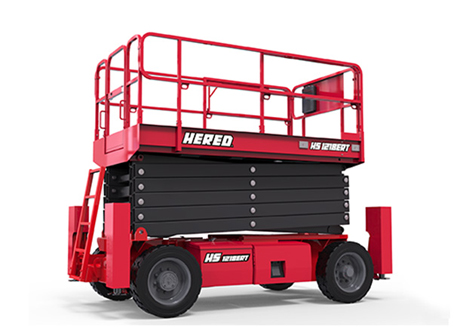Scissor lift operators and site managers at companies large and small take on a variety of tasks that can be handled more efficiently and safely with mechanical lifts suited to the task at hand. Site managers and operators use them to increase productivity, improve safety and save money, but they are only effective if the equipment they use is right for the job. Scissor lifts can be used for a variety of purposes, but if they don't have the right size, capacity, height, or other specifications for the job, the results can be detrimental.
Operators and site managers benefit from knowing some aerial lifts, such as scissor or boom lifts, which are often the easiest way to reach high work areas. Purchasing or renting a scissor lift is an essential step for any contractor. At Hered, we can assist with all aspects of the process, from the initial consultation to the selection of a scissor lift.
Scissor lifts are machines that are used to move equipment and people up and down vertically. As such, these lifts can be used for any application that would normally require a ladder, tower, or scaffolding. The use of scissor lifts allows operators to do the same job faster and safer without the instability of setting up other equipment (such as scaffolding or towers) or ladders.
Rough Terrain Scissor Lift
Scissor lifts offer safety harnesses or cables and a sturdy platform surrounded by railings to minimize your risk of falling while working at any height. Scissor lift work platforms provide unparalleled safety for all types of work that occurs at low to medium altitudes. The technical classification of scissor lifts can be referred to as one of the following.
Mobile Elevated Work Platforms (MEWP)
Aerial Work Platforms (AWP)
Elevated Work Platforms (EWP)
The platform and railing are supported by a beam or rod strut on the lift, which is usually made of steel. Because the struts are hinged together, the assembly looks like a series of connected scissor blades, and, when they operate, they perform an opening and closing motion like scissors. The scissor action that achieves the lifting force is powered by a hydraulic mechanism that provides power for the X-mode.

Scissor Lifts For Rough Terrain
Scissor lifts typically operate from 20 to 40 feet in height, but some models can extend much higher. Scissor lifts can extend up to 100 feet vertically. It is possible to move some scissor lifts back and forth with partial extension, but this should be done with great care. It is always a good idea to read the lift's owner's manual for safety precautions when moving the lift.
Scissor lifts typically extend 10 to 60 feet vertically and the working height is usually between 20 and 40 feet, although some models can go higher. Platform. Another advantage of scissor lifts is their small size, ranging from 5 to 9 feet in height and 2 feet 6 inches to 5 feet 9 inches in width when folded. Lifts can be mounted on four wheels or legs, or they can have outriggers that reach into or into the ground for added stability. Scissor lifts can run on electricity and/or batteries, while others use gasoline, diesel, or other types of fuel.
While some machines are designed to operate indoors, such as those used for building maintenance or storage, rough terrain scissor lifts (RTS) can withstand outdoor conditions and challenging paths. While some tires are unmarked, others are not. In order to obtain or rent a scissor lift, the first thing to consider is what kind of work it will perform and under what conditions. Several scissor lift models do not emit any emissions and operate quietly.
See all of our aerial lift platforms here.
Copyright:@2020-2021
Comments Please sign in or sign up to post.
0
0 of 500 characters used